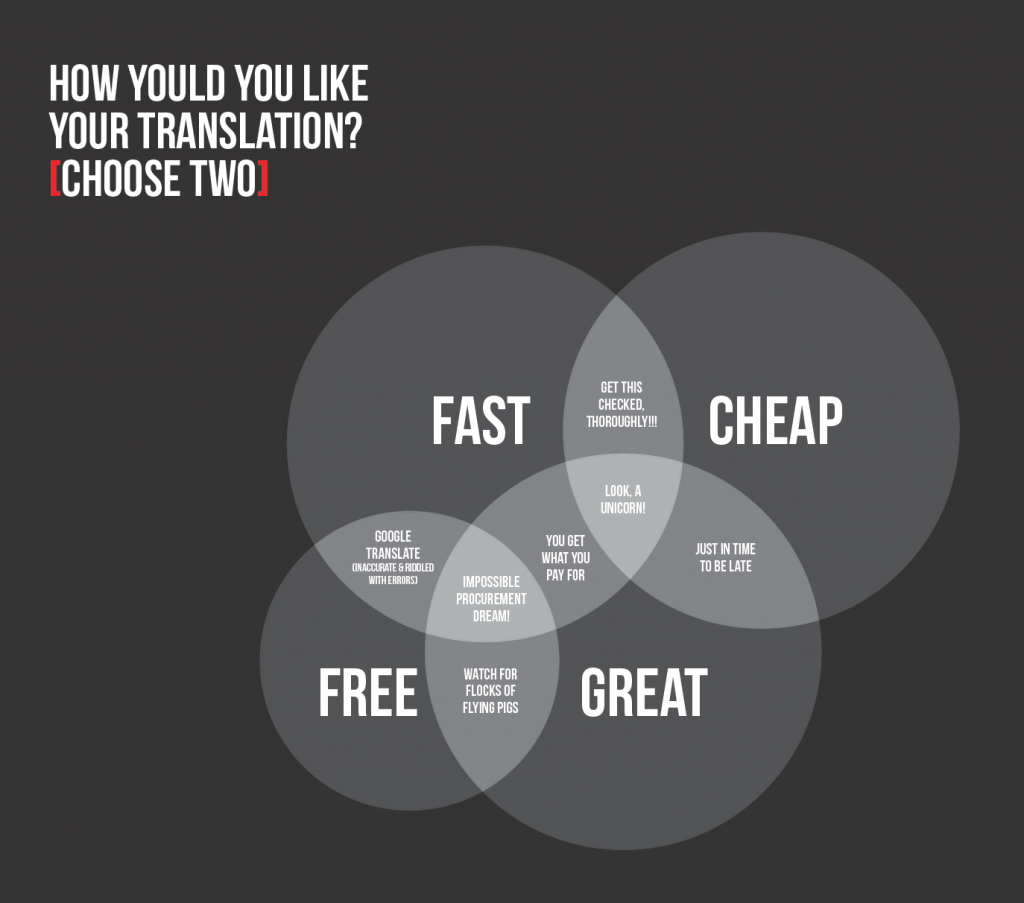The 3 Constraints That Define a Successful Localization Project
As a buyer and consumer of language services, you have a certain expectation for quality.
What you may not know is that there are three constraints that play a role in achieving quality.
The last thing you want is to be disappointed by the translation vendor you’re working with, right?
If I were in your shoes, I certainly wouldn’t.
And if I was dissatisfied, I would even go as far as looking to establish a business relationship with another translation vendor.
But why go through the disappointment, when you can do things right from the start?
Here is how you can set yourself up for success before each localization project for your organization.
This applies to something as basic as a one-page letter that takes a day to translate, or as complicated as a large eLearning localization project that will last several months.
The 3 Constraints of Localization Projects
The 3 constraints that define a successful localization project are: scope, time and cost.
Read on to find out how they correlate and impact your expectation of quality.
1. Scope
The scope includes all work that will be done during the project.
As a project sponsor or customer, set your expectations for the project with the translation vendor you’re working with.
It’s critically as important to have processes in place to verify the scope once the project is completed.
There is always a chance that certain content doesn’t need to be translated or localized. Learn more about that here.
2. Time
The time component measures how long it will take to complete the project.
Your expectations of turnaround time may be different than what’s realistically possible.
Your translation vendor will work with you to agree on a mutually acceptable timetable.
Defining a formal deliverables schedule is recommended. Your translation vendor may even have a delivery schedule template they can supply for this purpose.
3. Cost
The project cost is the third and final constraint of a localization project.
You have a budget to work with and any overruns can cause fiscal problems that impact your entire organization.
It’s generally a good idea to get estimates from various translation vendors.
However, don’t be fooled by the lowest price. Fast and cheap quality translation comes at a price that you are not ready to pay.
Lastly, don’t forget to define who can authorize changes to the budget and how the costs will be tracked.
Setting Scope, Time and Cost Targets
The most important thing you can do before approving the project with your translation vendor is set specific targets for each of the three constraints in the beginning of the project.
For example, a large eLearning localization project might have an initial scope of translating course materials into 12 languages, localizing the audio-visual components and recording multilingual voice-overs for each video.
With the help of your assigned translation project manager, you might further define the project scope to include a rough time and cost estimate, and assessments of the risk and potential payoff as high, medium or low.
The initial time estimate for this project might be three months, and the cost between $65,000 and $75,000.
You will notice that for large scale projects, the scope, time and cost targets should always be defined in ranges. Rarely does a localization project end up hitting precise targets.
For small projects, your translation vendor can generally provide you with a precise time and cost estimate. Here’s how you can get a quick translation estimate from any vendor.
Understand that because localization projects involve uncertainty and limited resources, they rarely finish according to a discrete scope, time and cost goals according to the original plan.
In the end, you and your translation vendor should have an understanding to hit the target, not the bull’s eye.
How Scope, Time and Cost Relate to Each Other
You have to be ready to make trade-offs between scope, time and cost goals for the project. For example, you might need to increase the budget for the project to meet scope and time goals.
Alternatively, you might have to reduce the scope of a project to meet time and cost goals.
Ultimately, you must decide which aspect of the triple constraint is more important.
Your assigned translation project manager can make recommendations to help you with the decision.
If time is most important, you must often change the initial scope and cost goals to meet your desired turnaround time. If scope goals are most important, you may need to adjust time and cost goals.
Scope, Time and Cost in Relation to Quality
Quality considerations, including customer satisfaction, are inherent in setting the scope, time and cost goals of a localization project.
Even if your translation vendor meets the scope, time and cost goals of the project, but fails to meet quality standards or satisfy your expectations as a customer, you will perceive the project as a failure and may seek another vendor to work with.
The best way to ensure customer satisfaction and address quality expectations is through consistent communication between you and the translation vendor.
For a three-month long project, it’s not uncommon to have weekly meetings to ensure the project is going according to plan.
Your assigned translation project manager should be communicating with you throughout the project to make sure the project is meeting your expectations.
Visualizing the Triple Constraint and Quality Expectations
Here is a nice graphic to help you visualize the concepts of this article.
Big thanks to Richard Brooks and the team at K International for putting this graphic together.
Conclusion
As a buyer and consumer of languages services, here is how you can avoid the problems that occur when your translation vendor meets the scope, time and cost goals, but loses sight of quality or customer satisfaction.
The answer is through consistent communication and good project management.
Understanding that a localization project is more than just about meeting the triple constraint of scope, time and cost will set you and your organization up for success.
Ultimately, it’s the quality and customer satisfaction that will determine if the project is successful.
Has your translation vendor met your localization project expectations?
Share your stories in the comments.








Leave a Reply
Want to join the discussion?Feel free to contribute!